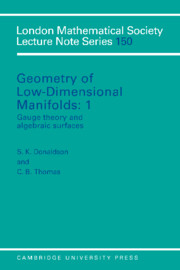Book contents
- Frontmatter
- Contents
- Contributors
- Names of Participants
- Introduction
- Acknowledgments
- PART 1 FOUR-MANIFOLDS AND ALGEBRAIC SURFACES
- PART 2 FLOER'S INSTANTON HOMOLOGY GROUPS
- PART 3 DIFFERENTIAL GEOMETRY AND MATHEMATICAL PHYSICS
- 11 Skyrme fields and instantons
- 12 Representations of braid groups and operators coupled to monopoles
- 13 Extremal immersions and the extended frame bundle
- 14 Minimal surfaces in quaternionic symmetric spaces
- 15 Three-dimensional Einstein-Weyl geometry
15 - Three-dimensional Einstein-Weyl geometry
Published online by Cambridge University Press: 16 February 2010
- Frontmatter
- Contents
- Contributors
- Names of Participants
- Introduction
- Acknowledgments
- PART 1 FOUR-MANIFOLDS AND ALGEBRAIC SURFACES
- PART 2 FLOER'S INSTANTON HOMOLOGY GROUPS
- PART 3 DIFFERENTIAL GEOMETRY AND MATHEMATICAL PHYSICS
- 11 Skyrme fields and instantons
- 12 Representations of braid groups and operators coupled to monopoles
- 13 Extremal immersions and the extended frame bundle
- 14 Minimal surfaces in quaternionic symmetric spaces
- 15 Three-dimensional Einstein-Weyl geometry
Summary
Abstract. I review what is known about 3-dimensional Einstein-Weyl spaces.
Introduction.
The Einstein-Weyl equations are a naturally-arising, conformally-invariant, generalisation of the Einstein equations. In the special case of 3-dimensions, the Einstein equations on a space force it to have constant curvature. The metric is then characterised locally by a single number, the Ricci scalar. By contrast, the Einstein-Weyl equations allow some functional freedom locally. Further, the equations fall into the small class of non-linear partial differential equations which can be solved by the twistor correspondence.
In this article I shall review the definition of an Einstein-Weyl structure (§2) and its twistor correspondence (§3). I also give some examples of Einstein-Weyl spaces (§4), and describe some general and some particular properties (§5, §6).
I am very grateful to the organisers of the LMS Durham Symposium for inviting me to take part in a most stimulating and worthwhile conference.
Einstein-Weyl spaces.
A Weyl space is a smooth (real or complex) manifold W equipped with
(1) a conformal metric
(2) a symmetric connection or torsion-free covariant derivative (the Weyl connection)
which are compatible in the sense that the connection preserves the conformal metric.
This compatability ensures in particular that orthogonal vectors stay orthogonal when parallel propogated in the Weyl connection and that the null geodesies, which can be defined just given a conformal metric, are also geodesies of the Weyl connection.
In local co-ordinates (or using the “abstract index convention” [8]) we write a chosen representative g for the conformal metric as gab and we write the Weyl covariant derivative as Da.
- Type
- Chapter
- Information
- Geometry of Low-Dimensional Manifolds , pp. 237 - 246Publisher: Cambridge University PressPrint publication year: 1991



